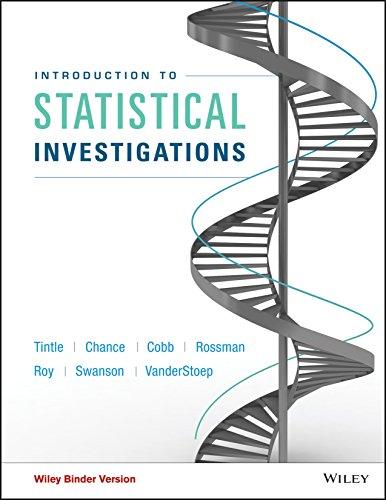A group of statistics students wanted to investigate the effect of social media on a persons self-esteem.
Question:
A group of statistics students wanted to investigate the effect of social media on a person’s self-esteem. For this purpose, they conducted a study where participants were randomly assigned to one of three groups: browsing ENews for 2 minutes and then taking a survey, browsing Facebook for 2 minutes and then taking the survey, or a control group where the participant just took the survey. The survey, based on the Rosenberg self-esteem scale, was the tool used to measure each participant’s self-esteem. Each participant was then given a score based on their responses to the survey, and higher scores are considered indicative of higher self-esteem.
a. Is this an experiment or an observational study? How are you deciding?
b. Identify the observational units.
c. Identify the explanatory and response variable. Also, for each variable, identify whether categorical or quantitative.
d. State the appropriate null and alternative hypotheses in words.
e. State the appropriate null and alternative hypotheses in symbols. Be sure to define the symbols used. The data file is SocialMediaandSelfEsteem.
f. Use an appropriate applet to use a simulation-based approach to find a p-value to test the hypotheses stated.
g. Recall that the theory-based test of significance in this scenario is called the ANOVA test or F-test. Use technology (either an applet or statistical soft ware) to implement the ANOVA test to test whether self-esteem scores differ significantly for any of the treatments. Be sure to report the F-statistic and the corresponding p-value.
h. Based on the p-value reported in part (g), state an appropriate conclusion in the context of the study. Be sure to comment on statistical significance, causation, and generalization along with how you are making your decision.
i. State the conditions under which the results from the theory-based ANOVA test would be valid. In the context of this study, is it valid to use the ANOVA test? Explain how you are deciding.
j. If appropriate, perform follow-up analysis. If you do not think follow-up analysis is appropriate, explain why not.
Step by Step Answer:

Introduction To Statistical Investigations
ISBN: 9781118172148
1st Edition
Authors: Beth L.Chance, George W.Cobb, Allan J.Rossman Nathan Tintle, Todd Swanson Soma Roy





